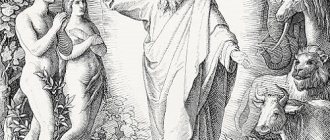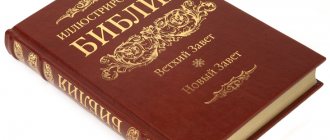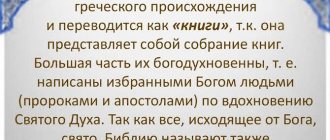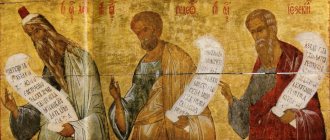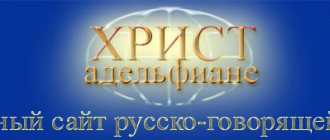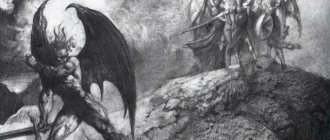The story told in the Pentateuch.
The unity of the Pentateuch comes from the unity of the story told in five books. God creates the world and paradise for man, man eats fruit from the tree of knowledge, for which God expels him from paradise, but blesses his offspring. The human race grows, man's possessions expand, but his bad behavior provokes God to send the Great Flood to wipe out all sinners from the face of the earth, except the righteous Noah and his family. After the flood, the world is again populated by the descendants of the three sons of Noah - Ham, Shem and Japheth. From them descended all the peoples of the civilized world. Noah's descendant Abraham receives a promise from the Lord - the land of Canaan. Despite all the trials, Abraham's son Isaac receives ownership of the Canaanite lands. His descendant Jacob becomes the father of twelve sons (which is why he is later called “Israel”).
This is the story as a whole, let's look at its development through the books.
Collection structure
We deliberately do not immediately answer the stated question of how many books are in the Bible. Unfortunately, it will not be possible to reveal it clearly and directly. Having read the material to the last line, you yourself will agree with this. The collection is divided into two parts – the Old and New Testaments. They were written by different authors over more than one and a half thousand years. The Old Testament is the name given to the pre-Christian part of the Bible (sometimes it is referred to as the Jewish part). These books were recognized by the Savior; he relied on them and used them as the Word of God. Jews recognize only one part of Holy Scripture, consisting of the Torah, Neviim and Ketuvim. On the basis of these books, all others were created, like Christianity itself.
The New Testament contains a description of the life of the Savior and his disciples. These volumes were created after Christ came into the world. All manuscripts, as already said, are very ancient. They have been reprinted many times. Because of this, confusion arose with the division into volumes. Thus, in the Jewish tradition, depending on views and preferences, it is generally accepted that there are 24 or 22 books. And modern Christians have already published thirty-nine volumes from these texts.
The first book of the Pentateuch.
The first book of the Pentateuch of Moses is GENESIS. Described here:
| History of the creation of the world |
| History of the creation of man |
| The story of Adam and Eve |
| The Story of Cain and Abel |
| History of the Great Flood |
| Babel |
| Abraham's story |
| History of the Sacrifice of Isaac |
| The story of Isaac and Rebekah |
| Sodom and Gomorrah |
| The story of Lot and his daughters |
Historical volumes
This part of the Bible consists of literature that is narrative in nature. The manuscripts contain information about how the people lived, what they thought, and what tasks they set for themselves. For example, the book of Joshua tells of the events that occurred from the death of Moses to the death of the author himself. It is often classified with the Pentateuch, since this volume logically follows it. However, in content it is historical and descriptive.
The book of Joshua is traditionally named after its author. It is believed that only its last lines were written by another person (the prophet Samuel). This volume, like others in this section, contains historical information of great value. This book contains stories about military battles and the law of that time. Scientists rely on its content in their work, since the time of its writing is well known. The historical section includes the books of Samuel and Kings, Chronicles and others. Educational and poetic literature is Psalms, Proverbs, Songs of Songs.
Second Book of the Pentateuch
The second book of the Pentateuch is the Book of Exodus. Described here:
| 10 Plagues of Egypt |
| The Wanderings of Moses and the Exodus from Egypt |
| The Story of Manna from Heaven |
| 10 commandments |
Prophecies
The last section consists of volumes describing the revelations received by the authors. For example, the book of the Prophet Haggai contains instructive speeches delivered to the builders of the temple. These messages were aimed at maintaining the fortitude of the ancient workers, who succumbed to despondency and were ready to abandon their intention.
The prophet told his contemporaries about the value of their work, connecting it with what God expected from his people. The meaning of his speeches is also interesting in our time to people seeking to join the faith. The book of the Prophet Zechariah also has an instructive meaning. This man received revelations about how to turn away from evil and go to God. He passed all of them on to his descendants.
Who wrote the Pentateuch and when?
Until the seventeenth century, the almost unanimous answer of Jews and Christians to this question was “Moses.” Moses wrote the Pentateuch, as David says in the Psalter, and no one dared to doubt it, although even then many noticed inconsistencies and duplicates in the narrative. For a long time, everything was explained by the theory of divine inspiration: God inspired Moses, and he wrote with the words of God. However, if we look at the end of the Pentateuch, we see that the Book of Deuteronomy ends with a description of the death of Moses. How would Moses describe his own death? This discrepancy was usually explained by one of the following options:
- Moses described his own death as dictated by God,
- The last lines of the Pentateuch were written by Joshua.
With the rise of historical criticism, scholars have begun to use duplicates and inconsistencies in the text to argue that the Pentateuch has multiple authors.
By the end of the nineteenth century, the leading theory of the authorship of the Pentateuch was that the Pentateuch was written down during the Age of the Judges (c. 1220-1020 BC) according to oral tradition.
Today, the main version of the origin is the version of 4 sources (DOCUMENTARY VERSION), which were combined into one and underwent several (at least three) editions. The following arguments support this point of view:
- The presence of repetitions - there are more than 25 of them in the Pentateuch. Repetitions are sometimes contradictory in detail, sometimes the versions complement each other.
- Different terminology in different books and parts of books.
- The difference in theological concept is visible throughout all 5 books.
Documentary hypothesis of the origin of the Pentateuch.
According to this hypothesis, the Pentateuch of Moses was written based on 4 sources:
- Yahwist
- Elohist / Elohist
- Deuteronomy
- Priestly Code
Let's look at the sources of the Pentateuch and their features.
YAHWIST or Source J is the oldest part of the Pentateuch. The Yahwist dates back to the 9th-10th century BC. e. The source received its name from the name of God Yahweh. The Yahwist is characterized by:
- God is anthropomorphic physically and spiritually,
- Positive attitude towards the Kingdom of Judah and criticism of the other tribes of Israel,
- Many borrowings from the Babylonian epic of Gilgamesh
It is the Yahwist who gives us stories about the Creation of the World and Man, about the Fall, about Cain and Abel, and also about the Tower of Babel. The Yahwist also contains details of the Great Flood and the Exodus from Egypt.
ELOHIST or source of E - its name comes from the word Elohim, a term used in Hebrew and Canaanite languages to name God. The source is usually dated to the end of IX BC. The story of the Elohist spring apparently begins with the story of Abraham. Moreover, according to this source, it is believed that Abraham sacrificed Isaac, and the intervention of the angel was the result of a later edition after human sacrifice had ceased to be practiced.
The Elohist is characterized by:
- Abstract idea of God
- Positive attitude towards the Northern Kingdom,
- Great role of angels
The Elohist gives a more detailed and detailed account of the exodus from Egypt than the Yahwist.
DEUTERONOMY. The authorship of the book is attributed to the Jerusalem clergy. This book is considered as whole and indivisible, unlike the four other books of the Pentateuch of Moses. It is very likely that Deuteronomy dates from the 14th to 13th centuries. BC e. Deuteronomy stands out from the entire Pentateuch in style, content, and genre, representing more of a sermon than a story.
PRIESTLY CODE. The Priestly Code includes genealogical lists, a description of the conclusion of the Covenants of God with Noah and Abraham. It also became the basis of the book of Leviticus.
Features of the Priestly Code:
- God is anthropomorphic.
- The main focus here is on cult.
It is believed that the sources were combined together after the fall of the Northern Kingdom. Deuteronomy was added a little later.
However, it should be said that the documentary hypothesis is also subject to criticism today. Scientists say that this approach greatly simplifies the situation, that there were many more sources and editions of the Pentateuch of Moses.
Traditional Judaism today denies the presence of several sources for the Pentateuch of Moses. Jews perceive the text of the Pentateuch as one and indivisible.
general characteristics
The word "bible" comes to us from the Greek language. It is translated as “books” or “scrolls”. Literally it means a collection of knowledge of great value. Probably, now we would put a different meaning into it, we would say that this is a library for the soul.
For several thousand years, these books (and there are many of them) have been considered one of the greatest treasures, relics created by ordinary people. They inspire, surprise and teach readers, prompting reflection and new discoveries. However, when the question arises of how many books are in the Bible, experts cannot answer unambiguously. And the point is not that the volumes are difficult to count. It’s just that different religious schools have formed their own attitude to this topic.
Works related to the Bible were created over a period of about one thousand six hundred years. One part - the Old Testament - was written in pre-Christian times. But it is also commonly referred to as Holy Scripture. Some theologians consider the New Testament to be a purely Christian revelation. And some of its volumes are not considered Holy Scripture. This is precisely where the differences in approaches lie. The value of this literature cannot be denied. Experts studying this topic view volumes from three perspectives.
The Personality of Moses in the Pentateuch.
From the Jewish point of view, the dominant figure of the Pentateuch is Moses. Abraham also plays an important role, but even his personality cannot compete with Moses. Although Moses was born into an ordinary Jewish family, he was raised by the daughter of Pharaoh and received an education worthy of the house of Pharaoh. Moses' concern for his people later in his life led to his exile from Egypt. After 40 years of wandering in the Midian desert, he spoke with God and appeared as a prophet. Moreover, he was a prophet of a special kind. God spoke not through him, but to him, face to face.
Important to Moses' prophetic role were the "signs and wonders" that the Lord performed through him, first in Egypt and then in the wilderness. The Prophet was also a man of prayer, interceding on behalf of others. Moses' intercession on behalf of Israel clearly demonstrates his role as a mediator between God and Israel. At Mount Sinai, Moses also played an important role in the creation of a national cult under the leadership of priests and Levites. Moses ordained the priests, who performed the prescribed sacrifices required by Levitical law. Thus, before Aaron was established as high priest, Moses was the first priest of Israel.
CHRONOLOGICAL FRAMEWORK OF THE PENTATEUCH—FROM GENESIS TO DEuteronomy
Chronology is the basis of history. Without an understanding of chronology there can be no historicity. Establishing the chronological framework of the events described in the Pentateuch is important for understanding the History of the Old Testament.
Establishing the chronological framework of the Pentateuch is problematic in the absolute sense, that is, in correlating a specific event with an exact year, but there is enough biblical data to correlate the time frame of one event with the time frame of another - so-called relative chronology. Typically, the absolute reference point for the New Testament is the birth of Christ.
There are many problems in establishing an absolute reference point for the Old Testament, including the Pentateuch.
The following dating sources are considered:
- Bible stories,
- Archaeological finds,
- Astronomical observations
If we compare modern chronology with the events described in the Pentateuch, we can obtain the following chronology of the main events:
- Creation of the first people - about 4000 BC,
- Great Flood - 2300 BC uh,
- Birth of Abraham - around 2000 BC,
- Life of Moses - XVI-XII centuries. BC e.
Interpretations. Accommodation method
The First Bible (Old Testament), and in particular the prophecies contained in it, has been interpreted by many churchmen and independent researchers throughout its existence. Unfortunately, very often the subjective opinion of the author prevailed over the objective meaning of a particular text. Simply put, ancient prophecies were interpreted in a strained manner when applied to the events of that historical era and the area in which the interpreter himself lived. This method is called the method of accommodation and is condemned both by ordinary researchers and by Christians themselves.
At the same time, the Church itself has more than once been accused of mechanically attracting Old Testament biblical texts to certain events and for a specific purpose. Gnostics in the second century AD believed, for example, that even Christ himself and the apostles interpreted the Old Testament not objectively, but attracted to their own teaching. However, Christians and many researchers are still confident: with regard to the coming of the Messiah and Jesus from Nazareth, the official interpretations of the church are far from the methods of accommodation.
